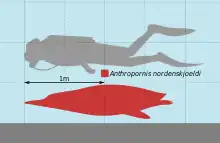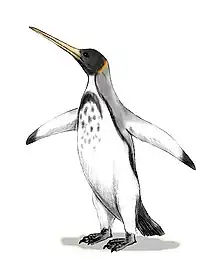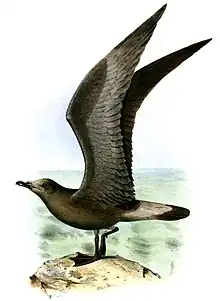| Anthropornis | |
|---|---|
 | |
| Size comparison of the Anthropornis nordenskjoeldi | |
| Scientific classification | |
| Domain: | Eukaryota |
| Kingdom: | Animalia |
| Phylum: | Chordata |
| Class: | Aves |
| Order: | Sphenisciformes |
| Family: | Spheniscidae |
| Subfamily: | †Palaeeudyptinae |
| Genus: | †Anthropornis Wiman, 1905 |
| Species | |
| |
Anthropornis is a genus of giant penguin that lived 45-33 million years ago, during the Late Eocene and the earliest part of the Oligocene.[1]
Description

Anthropornis reached 1.8 m (5 ft 11 in) in length from the tip of the beak to the tip of the tail, and 90 kg (200 lb) in weight. There is also an estimate that one remain of Anthropornis can reach that body length of 2.05 m (6 ft 9 in) and 108 kg (238 lb) in weight.[2] Fossils of it have been found in the La Meseta Formation on Seymour Island off the coast of Antarctica and in New Zealand. By comparison, the largest modern penguin species, the emperor penguin, is just 1.2 m (3 ft 11 in) long.
The type species, Anthropornis nordenskjoldi, had a bent joint in the wing, probably a vestigial trait from its flying ancestors.
References
- ↑ Myrcha, A., Jadwiszczak, P., Tambussi, C.P., Noriega, J.I., Gazdzicki, A., Tatur, A., and Valle, R.A. (2002). "Taxonomic Revision of Eocene Antarctic Penguins Based on Tarsometatarsal Morphology". Polish Polar Research, 23(1): 5-46
- ↑ "Body size of Eocene Antarctic penguins". Polish Polar Research.

